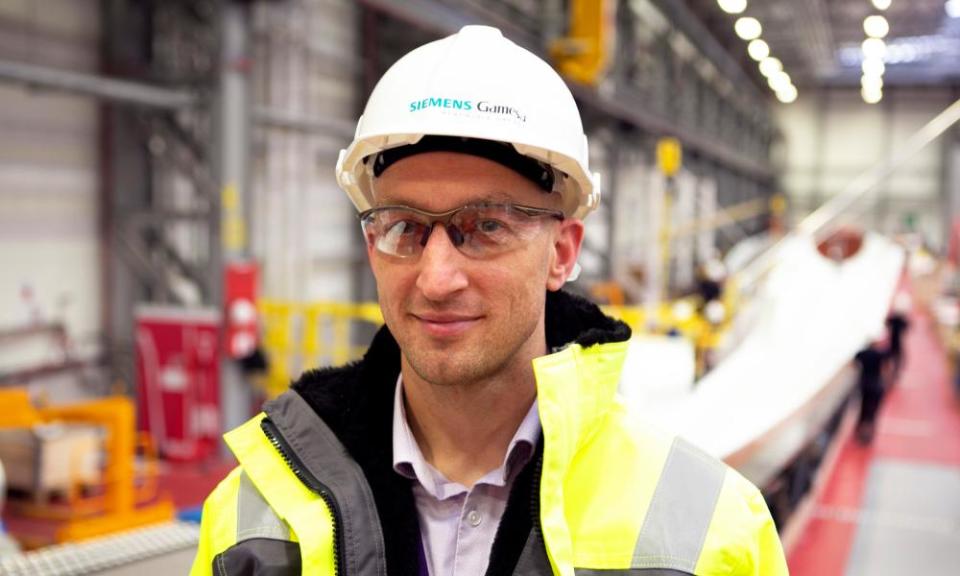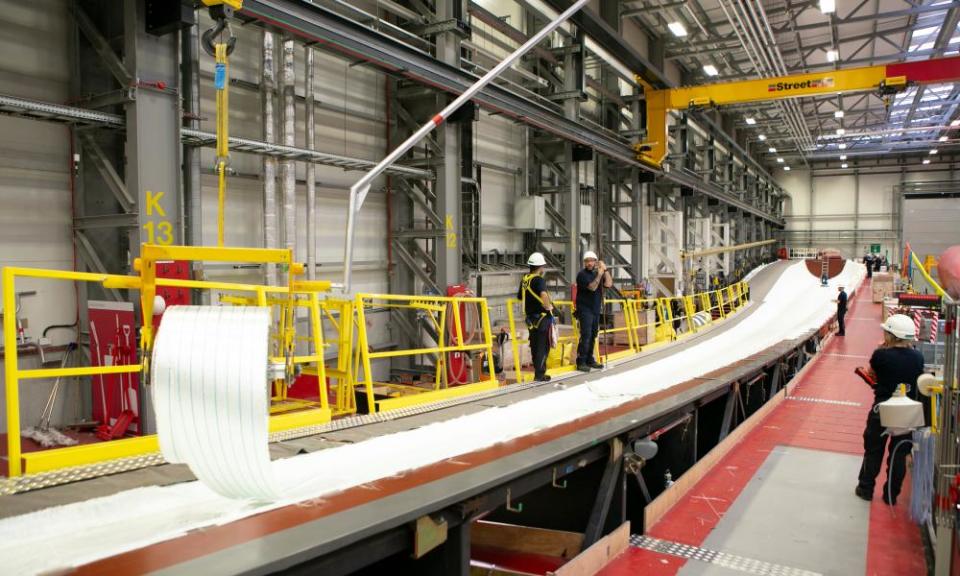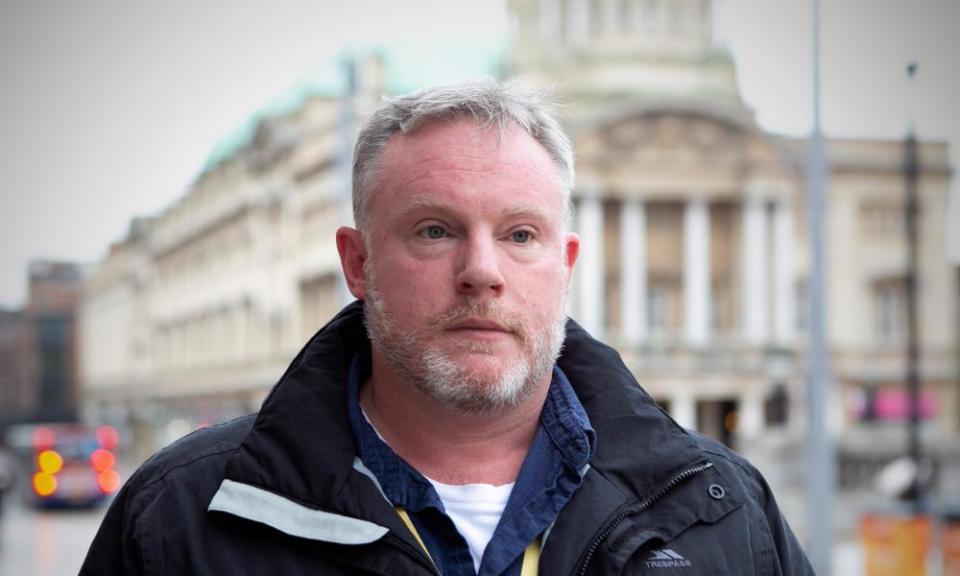‘Right direction’: Hull begins to turn towards a green energy future

The UK’s energy revolution has a surprisingly artisanal feel. In the vast halls of a wind turbine blade factory in Hull, workers manually unroll layers of fibreglass and balsa wood into 81-metre moulds, before resins and paint are added. The blades are then shipped to the middle of the North Sea to generate clean electricity.
They also generate jobs – 1,000 on the Siemens Gamesa site, plus another 200 to come after an investment of £186m to make bigger 108-metre blades. The site is the epitome of Boris Johnson’s claim that green jobs can help to “level up” Britain’s neglected regions.
Cities like Hull – long deprived of public or private investment – will be key tests of the country’s success in creating green industry. Yet there was little hint in the chancellor Rishi Sunak’s budget on Wednesday of how the government intended to respond to the climate crisis, even as the UK prepares to host the Cop26 summit.
“It seemed to be a pretty light budget and spending review in that context, which is surprising given Cop next week,” said Andrew Carter, the chief executive of Centre for Cities thinktank. More research and development spending could potentially help, but there was little detail of how that money would be spent, he added.
The shadow chancellor, Rachel Reeves, who has pledged to spend £28bn a year on green technology if Labour were in government, said the budget showed the UK was “burdened with a chancellor unwilling to meet the challenges” the country faced.
Recent weeks have brought some tentative signs that Hull may be building momentum towards a green energy future. Last week, the government announced fast-track funding for carbon capture centred on Hull and Middlesbrough, adding to the east coast’s ambitions to produce low-emissions hydrogen.

For Andy Sykes, plant director at the Siemens Gamesa site, the projects were welcome symbols of Hull’s move into green energy. Sykes grew up in a former pit village down the road, where the shipyard and breweries eventually closed down. The blade factory is on city’s old Alexandra dock – which was built in 1885 to export coal, the most polluting major fossil fuel.
“I’ve seen the decline of this region,” said Sykes. “I’m just so proud to be part of its renaissance.”
Jürgen Maier, the former Siemens UK chief executive who oversaw the Hull turbine investment, and is vice-chair of the Northern Powerhouse Partnership, said the city’s experience offers a repeatable model for the green energy transition.
“To persuade people that this was one of the key technologies of the future, it was a journey,” he said. “I wish we would learn from what we did for wind for hydrogen.”

The budget did not have “enough scale and ambition” in helping companies to set up local supply chains, Maier said. “It seems there is not really the appetite to create more of a high wage economy in the supply chain companies of these exciting industries,” he said.
New industries need a long-term vision from government as well as detailed technical work on market structure, Maier said. A strategic plan on training is also important. “It took a bit longer than we hoped” to build up the right skills in the local workforce, he added.
If Hull could be the centre of a new green energy industry it could change the course of its politics. Hull is a staunchly Labour city. The three constituencies within the city boundary have returned Labour MPs since at least the 1950s. Yet Hull also voted by 68% to 32% in favour of leaving the EU, and the Brexit-backing Conservatives have made inroads in recent elections.

Diana Johnson, LabourMP for Kingston upon Hull North since 2005, argues that the leave vote reflected frustration at parts of the city being left behind economically. Areas of her constituency nearer the city centre such as the Avenues have relatively strong employment, but many others, like the Bransholme and Orchard Park housing estates on the north periphery, are among the most deprived in the country.
They have for the most part missed out on any green economy boost. Johnson highlighted the budget’s lack of money directed at “left behind communities”. She said: “The scale of the investment on offer is not transformative when compared to areas of the country that have seen real sustained regeneration, such as London Docklands.”
Seventy-five of 166 wards in Hull are ranked by the government among the 10% most deprived areas in England. About 8% of Hull’s working population claim unemployment benefits – the third-highest rate of any city in the country, according to Centre for Cities. Hull’s citizens also suffer more chronic illness than average – a heavy brake on the economy.
Carter said the higher minimum wage announced by Sunak would help Hull’s low-wage economy. However, many who receive universal credit have seen their household incomes drop after the chancellor removed a £20 a week pandemic uplift. Sunak on Wednesday bowed to pressure from opposition and some of his own backbenchers by reducing the rate at which benefits were to be removed from per extra hour worked.

However, the local Citizens Advice is worried that debt problems built up during the pandemic could be called in during the coming months, squeezing people just as energy prices and inflation jump.
“Winter is coming and it’s going to be a cold, hard winter for people already in a debt trap,” said Andy Coish, head of partnership projects at Citizens Advice Hull and East Riding.
Labour’s Johnson highlighted the absence of government policies to build up social capital in many of Hull’s poorer areas – funding for community groups, job clubs and literacy and numeracy classes rather than (or perhaps added to) roads and roundabouts. She wants the government to launch a community wealth fund that could use money sitting in dormant bank accounts.
“What worries me about the government’s ‘levelling up’ agenda is it seems very much boys’ toys,” Johnson said. “[There is] lots of hard infrastructure but I think we have to recognise that we need to do something different in those areas.”
When hard infrastructure investments are made, Hull has missed out again on faster trains and electrification, Hull’s Chamber of Commerce said. Hull and east Yorkshire were not mentioned by Sunak among £5.7bn in funding for regional transport, even as other parts of Yorkshire and northern England were promised hundreds of millions of pounds.
Hull has already gone through dramatic changes in the last century. The city suffered more damage during the blitz than anywhere outside London. Then its deep-water trawler fleet, once the UK’s largest, dwindled to almost nothing as the so-called cod wars cut off access to the coasts of Norway and Iceland.
However, there are some signs of increased confidence. Its designation in 2017 as the UK’s city of culture gave it some buzz, even although it is not clear that it has left much in the way of an economic legacy.
Budget documents promised funding for ongoing works on the main road running through the city, as well as support for regeneration projects at Whitefriargate and Albion Square in the city centre.
That could go some way to attracting businesses to empty shops on Hull’s high streets. The council has previously focused regeneration energies on the Fruit Market area by the marina on the Humber. Bars, cafes and shops have sprung up after the council and developers worked together to attract businesses.

“There was nothing really down here,” said Jade Talbot, the co-owner of Light and Scent, which sells candles, bath bombs and soap. She and her mother, Christine Lawson, opened the shop a year ago, and found it hard going during the lockdowns. However, they made it through thanks to a website launched at the same time, and Lawson said it feels like the city is picking up after the pandemic hit.
“I’m optimistic about it,” said Lawson. “We’ve got a long way but we’re going in the right direction.”

 Yahoo News
Yahoo News 